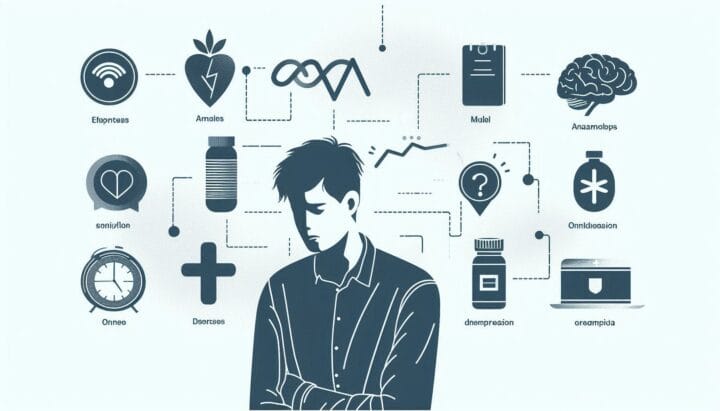Which of the Following is Not an Anxiety Disorder?
Table of Contents

Which of the Following is Not an Anxiety Disorder?
Ever felt your heart racing, palms sweating, and mind spinning for no clear reason? Welcome to the world of anxiety disorders. But here’s the twist: not everything that looks like anxiety fits into that category. Let’s explore this topic and figure out which condition doesn’t belong in the anxiety family.
The Anxiety Disorder Family: Who’s In and Who’s Out?
Anxiety disorders are like a big family reunion. Some members are obvious, while others might surprise you. Let’s meet the family and spot the outsider.
Common Anxiety Disorders
Here are the typical members of the anxiety disorder family:
- Generalized Anxiety Disorder (GAD): The one who worries about everything.
- Panic Disorder: The one who makes a scene suddenly.
- Social Anxiety Disorder: The shy one at every gathering.
- Specific Phobias: The picky eaters of the group.
- Agoraphobia: The one who prefers staying home.
- Separation Anxiety Disorder: The clingy one who can’t let go.
The Odd One Out: Obsessive-Compulsive Disorder (OCD)
Now, here’s where things get interesting. Obsessive-Compulsive Disorder (OCD) used to be considered part of the anxiety family, but it’s now recognized as its own separate condition.
Why OCD is Not an Anxiety Disorder
Surprise! According to the latest guidelines, OCD is no longer classified as an anxiety disorder. It has moved into its own category.
The OCD-Anxiety Connection
Even though OCD isn’t classified as an anxiety disorder anymore, it still shares some similarities with anxiety. People with OCD often feel anxious about their obsessive thoughts and compulsive behaviors.
Other Conditions That Can Look Like Anxiety
There are a few other conditions that can seem similar to anxiety disorders but don’t fit into that category:
Post-Traumatic Stress Disorder (PTSD)
PTSD used to be grouped with anxiety disorders but now stands alone. It involves intense reactions after experiencing or witnessing a traumatic event.
Acute Stress Disorder
This condition can occur after a traumatic event but is temporary. It’s related to stress but not classified as an anxiety disorder.
Recognizing Symptoms: Why It Matters
You might wonder why all this classification stuff is important. Well, knowing what you’re dealing with helps in finding the right treatment.
Tailoring Treatment: The Right Approach
Different conditions respond to different treatments. If you know exactly what you’re facing, it makes it easier for healthcare professionals to help you effectively.
Research and Awareness
Proper classification helps researchers understand these conditions better and develop new treatments.
Diagnosis: How Professionals Tell Them Apart
Diagnosing these conditions isn’t always straightforward because they can share symptoms:
Panic Attacks vs. Anxiety Attacks
While panic attacks are sudden and intense, anxiety attacks tend to build up over time.
Professional Assessment
Mental health professionals use specific criteria to determine which condition you might have, helping you get the right support.
The Future of Mental Health Classification
The way we categorize mental health issues is always changing as we learn more about them:
New Research: Fresh Insights
As scientists study these conditions more closely, new treatments and classifications may emerge.
Conclusion
So, which of the following is not an anxiety disorder? The answer is Obsessive-Compulsive Disorder (OCD). While it shares some features with anxiety disorders and often occurs alongside them, OCD is classified separately now. Understanding these differences helps in getting the right treatment and support. Remember, whether it’s an official anxiety disorder or not, all mental health challenges are real and deserve attention. If you’re feeling overwhelmed by anxiety or any related symptoms, don’t hesitate to reach out for help. You’re not alone in this!
FAQs
- Can you have both an anxiety disorder and OCD?
Yes, many people experience both conditions at the same time. - How is OCD different from generalized anxiety disorder?
OCD involves specific obsessions (thoughts) and compulsions (behaviors), while GAD involves more general worry about various life aspects. - Are there any new conditions being considered for classification as anxiety disorders?
Research is ongoing, and classifications may change as we learn more about mental health. - Can anxiety disorders turn into OCD or vice versa?
While they are distinct conditions, having one can increase the risk of developing the other over time. - How does reclassifying OCD affect treatment options?
This change allows for more specialized treatment approaches tailored specifically for OCD rather than treating it as just another anxiety disorder.












Post Comment